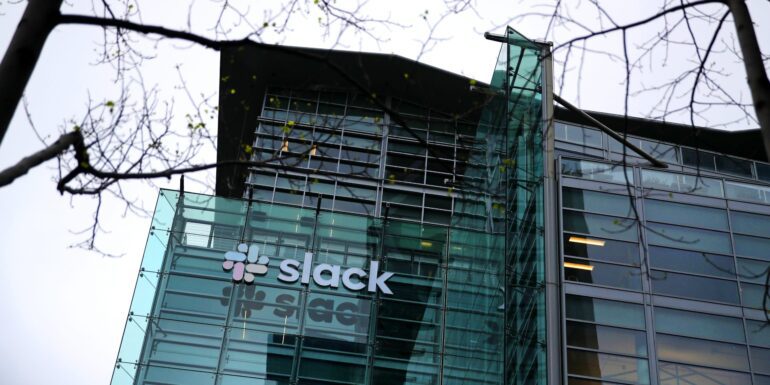TL;DR:
- Slack introduces AI at the forefront of the user experience.
- Integration of AI is an integral part of Slack’s architecture.
- ChatGPT app brings AI capabilities to the Slack environment.
- SlackGPT, a proprietary flavor of generative AI for Slack, enhances productivity and collaboration.
- AI-powered conversation summaries and writing assistance are introduced within Slack.
- Generative AI offers benefits in catching up on lengthy threads and generating Slack messages.
- Developers can incorporate generative AI into their workflows.
- Slack’s enhanced developer experience enables seamless integration of generative AI.
- EinsteinGPT, Salesforce’s generative AI, is integrated into Slack.
- Integration of Salesforce content streamlines collaboration between Slack and Salesforce.
Main AI News:
Slack’s transformation from a simple communication platform to a powerful tool connecting companies with enterprise applications has reached a new milestone. At the Salesforce World Tour event in NYC, Slack unveiled its latest advancement, placing artificial intelligence (AI) at the forefront of the user experience. This strategic move aims to streamline information retrieval and workflow construction, eliminating the need for cumbersome task switching.
It is important to note that these announcements are future developments, and while they represent exciting possibilities, the features are not yet accessible to users. Slack’s CEO, Rob Seaman, emphasizes that the integration of AI is not merely a superficial layer but rather an integral part of the platform’s architecture. In a recent collaboration with OpenAI, Slack took its first step towards this vision by introducing the ChatGPT app, currently available in beta, which brings AI capabilities directly into the Slack environment.
The latest announcement builds upon this foundation by introducing a range of new integrations, including SlackGPT, a proprietary flavor of generative AI specifically designed for the Slack platform. Both users and developers can leverage this technology to create AI-driven experiences that enhance productivity and collaboration. By utilizing the vast pool of content already present within Slack, such as messages, files, and shared clips, SlackGPT provides a robust starting point for developing AI models tailored to the platform.
“We believe that Slack possesses a unique advantage in the realm of generative AI. The wealth of institutional knowledge encompassing various topics, teams, work items, and projects is already embedded within Slack through daily exchanges,” explains Seaman. When combined with Slack’s extensive Partner ecosystem and versatile platform, customers gain a multitude of options for seamlessly integrating AI into their workflows. Slack is currently approaching this integration from three distinct angles.
Firstly, Slack aims to embed AI directly into the user experience through SlackGPT, empowering customers to work more efficiently, communicate effectively, and accelerate their learning curve. An illustrative example of this AI integration is the introduction of AI-powered conversation summaries and writing assistance, enabling users to access these features directly within the Slack interface. This seamless integration significantly enhances productivity and enables smoother collaboration within the platform.
As Slack continues to evolve and expand its AI capabilities, users can anticipate a future where AI serves as a fundamental pillar of their experience, facilitating seamless communication, intelligent assistance, and unparalleled efficiency. The integration of AI represents a transformative step for Slack, solidifying its position as a leading platform at the intersection of communication and innovation.
The potential of generative AI in the workplace is vast, offering various benefits to both employees and developers. One notable advantage is the ability to catch up on lengthy threads without the need to meticulously read every single message. This enables individuals to grasp the essence of the discussion quickly and efficiently. Another less apparent use case involves leveraging generative AI to create Slack messages or content for linked Slack applications. While composing a Slack message manually may be simpler, automated messages integrated into workflows can benefit from the assistance of generative AI, especially when working on Slack Canvas content.
Moreover, developers have the opportunity to harness the power of generative AI by incorporating AI capabilities into their workflows. By tapping into external applications and large language models, developers can build personalized generative AI experiences. Slack recently made its enhanced developer experience available to the public, facilitating the seamless integration of generative AI into the platform.
This update empowers users to embrace AI on their terms, providing them with flexibility and choice in incorporating AI into their business operations. With a robust ecosystem boasting 2600 apps, including leading LLMs (Large Language Models), numerous customers are already opting to integrate generative AI directly into Slack.
Furthermore, the integration of EinsteinGPT, Salesforce’s flavor of generative AI, into Slack enhances the collaboration between the two platforms. Employees can now directly inquire about Salesforce content, such as identifying customers with a high likelihood of churning or accounts with a higher probability of making a purchase. This integration streamlines the incorporation of Salesforce content into Slack, a move that Salesforce made when acquiring the platform for a staggering $27 billion a couple of years ago.
Conlcusion:
The integration of artificial intelligence (AI) into the Slack platform represents a significant milestone with far-reaching implications for the market. By placing AI at the core of the user experience, Slack is poised to revolutionize communication and collaboration within enterprises. The seamless integration of generative AI, such as SlackGPT, empowers users to work more efficiently, streamline workflows, and enhance productivity.
Furthermore, the incorporation of AI capabilities into developer workflows opens up a new realm of possibilities for personalized generative AI experiences. With the integration of Salesforce’s EinsteinGPT, the collaboration between Slack and Salesforce strengthens, enabling users to leverage AI-driven insights for improved decision-making. As businesses continue to embrace AI and its transformative potential, Slack’s strategic move positions the platform at the forefront of the market, bridging the gap between communication and innovation.

